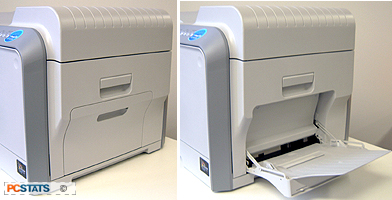 One of our favourite features of the CLP-550N is how quiet it
is. While not silent, it is certainly not intrusive. Tucked away in a side room
or by your desk, we doubt you'll notice it much. The 'operational' hum and
clatter of the printer as it processing a print job is also much louder than the
actual noise of pages being printed.
One of our favourite features of the CLP-550N is how quiet it
is. While not silent, it is certainly not intrusive. Tucked away in a side room
or by your desk, we doubt you'll notice it much. The 'operational' hum and
clatter of the printer as it processing a print job is also much louder than the
actual noise of pages being printed.
In several cases, we started a print job then turned our attention
elsewhere until the page was printed, only to realize a minute later that the
page had long ago come out, we just hadn't heard it. This quiet comes from a
patent-pending feature Samsung call the "NO NOIS" technology engine. Basically,
the mechanism for printing has been redesigned somewhat so that cartridges
remain stationary as the paper is moved past the magenta, cyan, yellow and black
colour cartridges.
Almost all necessary configuration options are available
within the Windows printer screens (accessed from the control panel.), including
the duplex mode option. The duplex mode itself works well, though the printer
has the rather alarming habit of spitting out the sheet of paper briefly then
sucking it right back in to print the other side, prompting us
to make futile, instinctual grabs for the half finished sheet on
a couple of occasions.
We encountered no errors or problems during our experience
with the Samsung CLP-550N. Once installed and running, it was a pleasure to
use in the office. As you would expect, we encountered no issues
with document smudging or toner leakage.
The top of the printer gets quite hot during
operation, and the manual requires that you leave considerable clearance on the top and
sides of the printer for proper operation. There was a bit of a 'toner'
smell, but it was only noticeable in the air immediately above the
printer.
In Use: Network Printing
Setting up the CLP-550N to work over the network was
fairly painless. The printer comes with a Samsung syncThru software CD
which you can use to remotely monitor and administer your Samsung
printer(s).

All configuration options in the CLP-550N's menu can be
accessed from the syncThru utility. A
compact version of the syncThru software can be used on other PCs
that need to access the printer. This simply adds the required port
to the 'add printer port' dialog box during printer installation, allowing the printer
to be added to Windows normally (with the required drivers). Printing over
the network worked exactly as it should have, with no slowdowns or
problems.
Cost per Printed Page
The CLP-550N's standard black ink cartridge costs ~$90
and yields up to 7000 sheets at 5% coverage. Taken at face
value, this works out to a cost per page (CPP) of 1.3
cents. For colour pages and black text with 5% coverage
of each colour, yield should be 5000 pages at $105
per cartridge x3 + the black ink, working out to a CPP
of around 8.1 cents.
Pages of mostly text with small areas of colour will work out considerably
cheaper than this of course, just as full page photos are much more
expensive. We'd put the cost of each full coloured page (for a printed photo or the like)
at about 32 cents.
Of course, the image
drum and transfer belt (~$140 each) are both rated at 50,000 sheets/12,500
colour sheets, and the waste toner container (~$18) will last for 12,000
sheets before needing replacement, so when these wear out more
calculation is required. for 50,000 black sheets at 5% coverage,
CPP should be be approximately 2 cents per page, with colour being
proportionately more expensive also.
To test pure text print speed, we ran a 24-page word
document (with about 5% coverage) through the printer. After an initial 15
second startup delay before the first page printed, the CLP-550N started
churning out documents at a ferocious pace.
The document finished at 1 minute and 24
seconds, working out to a little better than 17ppm. If you subtract the
initial time between the printer spooling up and the first page emerging, you
get 20ppm, which is within the margin for error of Samsung's 21ppm claim for the CLP-550N.
For testing the printer's speed in colour, we ran a 12-page Word document consisting solely of
images. The test run finished in 2 minutes, 32 seconds, making for
an average of 4.7ppm, rounding up to Samsung's rated 5ppm colour. Good results all around
in these tests.
